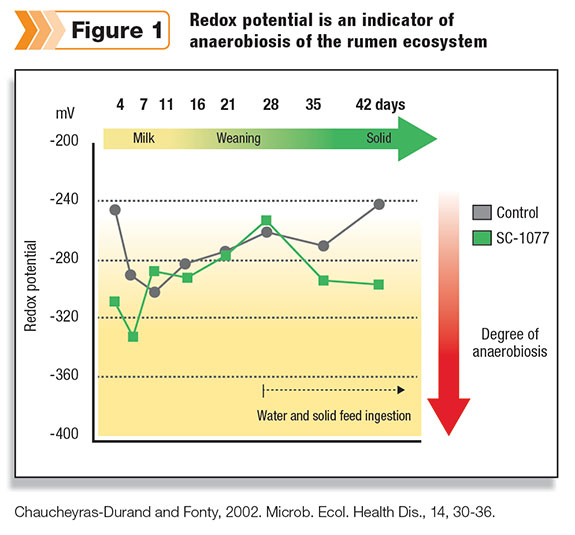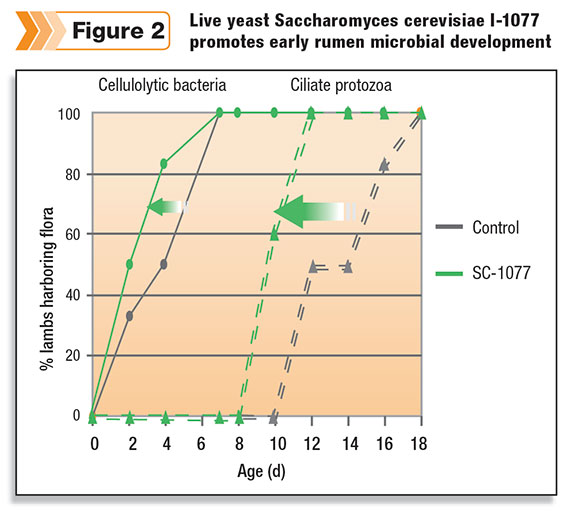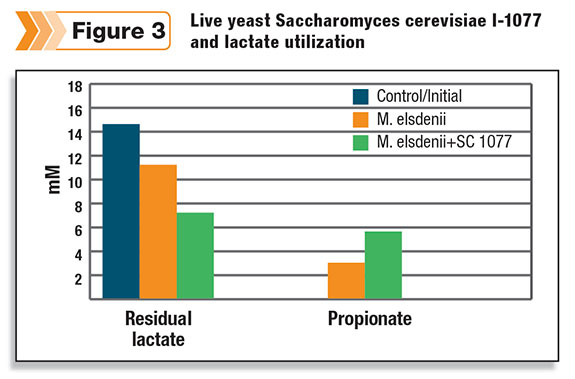This article is a summary of some very useful information recently presented at technical conferences in the U.S. by Dr. Frederique Chaucheyras-Durand from INRA, France. It also builds on the recent article “Yeast Products in Ruminant Feeds, What, Why, Where and When?” by Dr. Angel Aguilar in the April issue of Progressive Dairyman.
Dairy heifer calves: Developing their rumen
At birth, dairy calves are born initially with a sterile rumen and function as non-ruminants, beginning life on milk and milk-product feeds. However, calves are “hardwired” as ruminants, with the ability to digest fiber after weaning.

The key to successful weaning is free-choice water at all times, a palatable and digestible starter grain that will ferment to the key volatile fatty acids (VFAs) propionate and butyrate, plus the establishment of robust rumen microflora under anaerobic conditions.
Live yeasts included in starter feeds have been shown to improve oxygen utilization in the rumen.
By scavenging for oxygen, the live yeast helps reduce the rumen’s redox potential in favor of the all-important anaerobic rumen microbes (see Figure 1 ).
One live yeast strain (Saccharomyces

cerevisiae I-1077) has also been shown to promote a faster development of fiber-digesting bacteria and ciliate protozoa. See Figure 2 .
Rumen microbiologists use the presence of ciliate protozoa as a proxy for rumen maturity.
The practical consequence of this live yeast inclusion in starter feed for calves is faster rumen development, a smoother weaning transition with no reduction in bodyweight gain, with a 9 percent improvement in daily gain plus a 7 percent improvement in feed conversion ratio.
Live yeast and rumen pH
Depending on whether a ration is based on higher grain or higher forage inclusions, the ruminal digestion of the ingested carbohydrate fractions will generate VFAs and some lactate.
The amounts of VFA and lactate will vary according to ration type and feeding behavior. The meal sizes can be influenced by stress that can lead to sorting or slug-feeding (e.g., overcrowding at the feedbunk, heat stress, etc.).
The net result is a cyclic pattern of rumen pH throughout the day and times when cattle are below pH 5.7, which would be defined as sub-acute rumen acidosis, or SARA.
The effect of a rumen pH shift on rumen function and efficiency is manifold.
Prolonged bouts of SARA can be extremely detrimental to the cow: a decrease in fibrolytic bacteria populations; an increase in S. bovis and E. coli numbers; a reduction in some ciliate protozoa; a decrease in fungal zoospore numbers; an increase in the production of rumen endotoxins, triggering of an inflammatory response and changing the rumen wall integrity and permeability; a reduction in NDF digestibility; disrupted meal patterns and dry matter intake; production of CLA isomers; and variable milk production.
Rumen pH will decline in the presence of high VFA (acetate, butyrate and propionate) concentrations in the rumen fluid (more than 150 mM) when rapidly fermentable feeds are fed.
Also, whenever lactate does accumulate in the rumen, the rumen pH will fall further as lactate is a stronger acid than the VFAs.

Live yeast cells can stimulate the populations and activity of lactate-consuming bacteria (M. elsdenii and S. ruminatum), promoting the conversion of lactate into propionate.
In-vitro studies confirmed the yeast cells must be alive and metabolically active to stimulate the lactate uptake (see Figure 3 ).
Some of the co-factors produced by the live yeast strain that stimulated the lactate utilizing bacteria were also identified.
The pH effect in vivo was also confirmed in sheep and recently in dairy cows under heat stress.
Research in 2007 reported that the supplementation of live yeast increased average rumen pH by 0.5 units, with a significant reduction in time under pH 5.7 in freestall-housed dairy cows.
Moreover, in this study the eating pattern was significantly and favorably changed to smaller and more frequent meals in the live yeast-supplemented cows without any change in dry matter intake.
This phenomenon of the live yeast effect on meal frequency has also been observed in young growing cattle, with smaller and more frequent meals leading to higher daily gain, a more homogenous growth rate and an improved feed conversion ratio.
It appears that the stimulation by live yeast promoting the conversion of lactate to propionate in the rumen helps control rumen pH and provides more ruminal propionate for absorption across the rumen into the portal bloodstream.
This gluconeogenic chemical signal in the liver could in turn influence meal size and frequency with minimal effect on dry matter intake as per the hepatic oxidation theory.
Live yeast and NDF digestibility
A large portion of the ration energy intake for ruminants comes from the fermentation of plant cell walls. This is the fraction we label as neutral-detergent fiber, or NDF, in laboratory analyses.
Effective degradation of plant tissue NDF is primarily via rumen microbial enzymes secreted during microbial adhesion on accessible plant tissue.
A primary chemical factor determining microbial progress with respect to NDF digestibility (NDFd) and rate (kd) is the presence and amount of indigestible lignin, or plant maturity. Microbiologically, one limiting factor in the rumen is the presence of oxygen.
Rumen fiber-digesting bacteria (which are anaerobic) are sensitive to oxygen in the rumen as they do not possess the enzymes to detoxify it.
Oxygen readily enters the rumen via water, feed and the oxygenated capillary blood supply wrapped around the rumen. Oxygen’s presence reduces rumen cellulolytic bacteria numbers and limits plant fiber adhesion by bacteria and some fungi.
As noted above, live yeasts will use up the oxygen in the rumen and so reduce its negative impact on the rumen fiber-digesting microbes.
The negative effect of SARA on reduced NDFd (amount and rate) is well documented. It is the basis for the relationship between pH and NDFd rates in many dynamic ration formulation programs for dairy cows in the U.S.
The positive responses seen in forage NDFd when a strain-specific live yeast is fed can also be explained in part by the reduction in SARA exposure.
Ruminants which have received rumen-specific live yeasts as part of their diets have more abundant rumen populations of fibrolytic bacteria and higher fiber-degrading enzyme activities.
More interestingly, recent in-situ studies in Europe with dairy cows under non-SARA rumen conditions using grass-based and corn silage-based rations, were supplemented with the same strain-specific live yeast.
Both forages exhibited higher NDF degradation under these non-SARA conditions. A positive influence of the yeast on fiber-degrading fungi was a likely explanation and being researched further.
Live yeast and animal production
Strain-specific live yeast supplementation improves rumen function (less oxygen, lower redox, better average pH, less time below pH 5.7, smaller meals and increased NDF-d).
As noted above, dairy calves have significantly improved daily gains and feed conversion ratios. In a growing and finishing beef cattle meta-analysis, the live yeast increased the feed conversion ratio by +3 percent.
For lactating dairy cows a meta-analysis showed the strain-specific live yeast supplementation resulted in a statistically significant 2.0 pounds of extra fat-corrected milk per cow daily, with no increase in dry matter intake. Thus feed conversion efficiency was improved.
Live yeast’s mode of action in ruminants will vary by strain. Well-researched strains that are independently documented to have the many beneficial features discussed above will be of value to the producer and their nutritional adviser.
In the U.S., the current objective is to increase animal production per pound of dry matter intake. A rumen-specific strain live yeast can help deliver that goal as part of a well-managed feed strategy. PD
References omitted due to space but are available upon request. Click here to email an editor.

Tony Hall
Dairy Technical Service Manager
Lallemand Animal Nutrition





